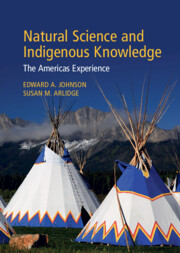Book contents
- Natural Science and Indigenous Knowledge
- Natural Science and Indigenous Knowledge
- Copyright page
- Contents
- Contributors
- Preface
- 1 What Do Indigenous People Have to Tell Us about the Cultural Landscapes They Have Created?
- 2 Reintegrating Cultural and Natural Landscapes
- 3 “My Uncle Was Resting His Country”: Dene Kinship and Insights into the More Distant Past
- 4 Native American Science in a Living Universe: A Paiute Perspective
- 5 “To Get More Harvest”
- 6 Hunting and Trapping in the Americas: The Assessment and Projection of Harvest on Wildlife Populations
- 7 On Fire and Water: The Intersection of Wetlands and Burning Strategies in Managing the Anthropogenic Plant Communities of Yosemite National Park
- 8 Indigenous Knowledge and the Kindergarten to Twelfth-Grade Science Classroom
- Index
- References
3 - “My Uncle Was Resting His Country”: Dene Kinship and Insights into the More Distant Past
Published online by Cambridge University Press: 11 April 2024
- Natural Science and Indigenous Knowledge
- Natural Science and Indigenous Knowledge
- Copyright page
- Contents
- Contributors
- Preface
- 1 What Do Indigenous People Have to Tell Us about the Cultural Landscapes They Have Created?
- 2 Reintegrating Cultural and Natural Landscapes
- 3 “My Uncle Was Resting His Country”: Dene Kinship and Insights into the More Distant Past
- 4 Native American Science in a Living Universe: A Paiute Perspective
- 5 “To Get More Harvest”
- 6 Hunting and Trapping in the Americas: The Assessment and Projection of Harvest on Wildlife Populations
- 7 On Fire and Water: The Intersection of Wetlands and Burning Strategies in Managing the Anthropogenic Plant Communities of Yosemite National Park
- 8 Indigenous Knowledge and the Kindergarten to Twelfth-Grade Science Classroom
- Index
- References
Summary
Although many might situate the most important traditional Indigenous knowledge in the realm of perceptive ecological awareness, there is a compelling argument to be made that there was a more critical, underlying realm of knowledge. As important as traditional ecological knowledge and effective, naturally sustained technologies were, the sophisticated knowledge involving kinship can legitimately be regarded as the critical factor that made possible the rich and complex history of at least 14,000 years of Indigenous life in the Americas. In settings like the Great Basin or boreal forest, extensive webs of kin relationships were essential in ensuring human presence throughout the millennia. Here, I sketch a profile of what can be learned from Dene (Athapaskan) kinship, so responsive in managing not just Subarctic but a wide range of environments in western North America. A “thought model” derived from Dene kin principles is helpful in grasping the unusual circumstances that founding Indigenous populations encountered once they had departed Pleistocene Beringia for a Western hemisphere entirely without human inhabitants: an epic human journey. Such thought models can, with judicious use, intersect with rapidly unfolding genetic and archaeological findings and thereby be applied to further our understanding of the dawn of Indigenous presence in the Americas.
Keywords
- Type
- Chapter
- Information
- Natural Science and Indigenous KnowledgeThe Americas Experience, pp. 32 - 106Publisher: Cambridge University PressPrint publication year: 2024
References
- 2
- Cited by

